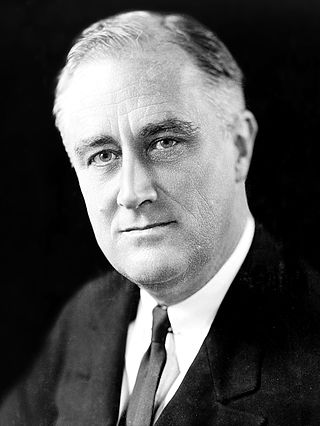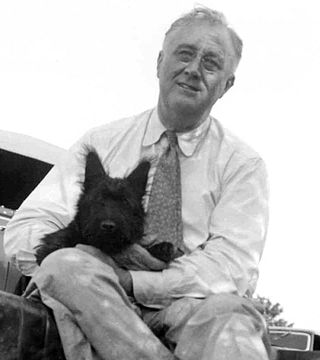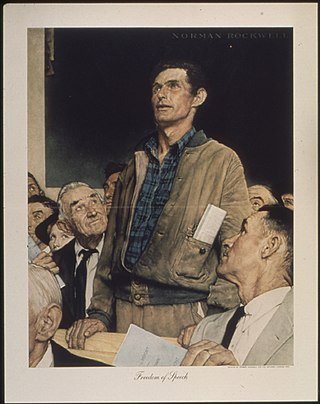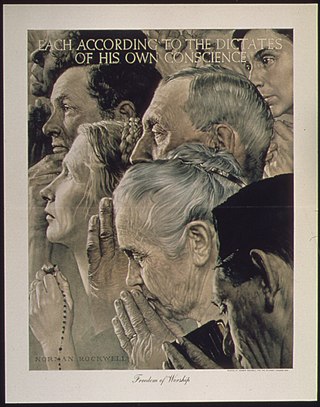Related Research Articles

The Four Freedoms were goals articulated by U.S. President Franklin D. Roosevelt on Monday, January 6, 1941. In an address known as the Four Freedoms speech, he proposed four fundamental freedoms that people "everywhere in the world" ought to enjoy:
- Freedom of speech and expression
- Freedom of worship
- Freedom from want
- Freedom from fear

The State of the Union Address is an annual message delivered by the president of the United States to a joint session of the United States Congress near the beginning of most calendar years on the current condition of the nation. The State of the Union Address generally includes reports on the nation's budget, economy, news, agenda, progress, achievements and the president's priorities and legislative proposals.

The 1932 United States presidential election was the 37th quadrennial presidential election, held on Tuesday, November 8, 1932. The election took place against the backdrop of the Great Depression. The incumbent Republican President Herbert Hoover was defeated in a landslide by Democrat Franklin D. Roosevelt, the governor of New York and the vice presidential nominee of the 1920 presidential election. Roosevelt was the first Democrat in 80 years to simultaneously win an outright majority of the electoral college and popular vote, a feat last accomplished by Franklin Pierce in 1852, as well as the first Democrat in 56 years to win a majority of the popular vote, which was last achieved by Samuel J. Tilden in 1876. Roosevelt was the last sitting governor to be elected president until Bill Clinton in 1992. Hoover became the first incumbent president to lose an election to another term since William Howard Taft in 1912, the last to do so until Gerald Ford lost 44 years later, and the last elected incumbent president to do so until Jimmy Carter 48 years later. The election marked the effective end of the Fourth Party System, which had been dominated by Republicans. It was the first time since 1916 that a Democrat was elected president.

The 1936 United States presidential election was the 38th quadrennial presidential election, held on Tuesday, November 3, 1936. In the midst of the Great Depression, incumbent Democratic President Franklin D. Roosevelt defeated Republican governor Alf Landon of Kansas in a landslide victory. Roosevelt won the highest share of the popular vote (60.8%) and the electoral vote since the largely uncontested 1820 election. The sweeping victory consolidated the New Deal Coalition in control of the Fifth Party System.

Alfred Mossman Landon was an American oilman and politician who served as the 26th governor of Kansas from 1933 to 1937. A member of the Republican Party, he was the party's nominee in the 1936 presidential election, and was defeated in a landslide by incumbent president Franklin D. Roosevelt. The margin of victory in the electoral college was the largest of Roosevelt's 4 elections to the office of president, as Landon won just 8 electoral votes to Roosevelt's 523. Landon lived to the age of 100 and died in October 1987. Landon would be the only presidential candidate from either party to live to 100 until Jimmy Carter in 2024 and Landon is the only Republican to do so.

The fireside chats were a series of evening radio addresses given by Franklin D. Roosevelt, the 32nd President of the United States, between 1933 and 1944. Roosevelt spoke with familiarity to millions of Americans about recovery from the Great Depression, the promulgation of the Emergency Banking Act in response to the banking crisis, the 1936 recession, New Deal initiatives, and the course of World War II. On radio, he quelled rumors, countered conservative-dominated newspapers, and explained his policies directly to the American people. His tone and demeanor communicated self-assurance during times of despair and uncertainty. Roosevelt was regarded as an effective communicator on radio, and the fireside chats kept him in high public regard throughout his presidency. Their introduction was later described as a "revolutionary experiment with a nascent media platform."

Joseph Wellington Byrns Sr. was a U.S. politician. He served as a 14-term Democratic congressman from Tennessee, and as the 41st speaker of the United States House of Representatives.

Samuel Irving Rosenman was an American lawyer, judge, Democratic Party activist, and presidential speechwriter. He coined the term "New Deal", and helped articulate liberal policies during the heyday of the New Deal coalition. He was the first person to hold the position of White House Counsel.

The 74th United States Congress was a meeting of the legislative branch of the United States federal government, composed of the United States Senate and the United States House of Representatives. It met in Washington, D.C., from January 3, 1935, to January 3, 1937, during the third and fourth years of Franklin D. Roosevelt's presidency. The apportionment of seats in the House of Representatives was based on the 1930 United States census.

The Second Bill of Rights or Bill of Economic Rights was proposed by United States President Franklin D. Roosevelt during his State of the Union Address on Tuesday, January 11, 1944. In his address, Roosevelt suggested that the nation had come to recognise and should now implement a "Second bill of rights". Roosevelt argued that the "political rights" guaranteed by the Constitution and the Bill of Rights had "proved inadequate to assure us equality in the pursuit of happiness". His remedy was to declare an "economic bill of rights" to guarantee these specific rights:

Fala, a Scottish Terrier, was the dog of United States president Franklin D. Roosevelt. One of the most famous presidential pets, Fala was taken to many places by Roosevelt. Given to the Roosevelts by a cousin, Fala knew how to perform tricks; the dog and his White House antics were mentioned frequently by the media and often referenced by Roosevelt and his wife Eleanor. Fala outlived Roosevelt by seven years and was buried near him.

Freedom of Speech is the first of the Four Freedoms paintings by Norman Rockwell, inspired by United States President Franklin D. Roosevelt's 1941 State of the Union address, known as Four Freedoms.

Freedom of Worship or Freedom to Worship is the second of the Four Freedoms oil paintings produced by the American artist Norman Rockwell. The series was based on the goals known as the Four Freedoms enunciated by Franklin D. Roosevelt, president of the United States from 1933 to 1945, in his State of the Union Address delivered on January 6, 1941. Rockwell considered this painting and Freedom of Speech the most successful of the series. Freedom of Worship was published in the February 27, 1943, issue of The Saturday Evening Post alongside an essay by philosopher Will Durant.

The first inauguration of Franklin D. Roosevelt as the 32nd president of the United States was held on Saturday, March 4, 1933, at the East Portico of the United States Capitol in Washington, D.C. This was the 37th inauguration, and marked the commencement of the first term of Franklin D. Roosevelt as president and John Nance Garner as vice president.

Liberty Fleet Day was first observed on 27 September 1941, the day that 14 merchant ships were launched in shipyards across the United States under the Emergency Shipbuilding program. Among the ships launched was the first Liberty ship, SS Patrick Henry. Some of the merchant ships were subsequently converted to other purposes, including as troop transports and a Royal Navy aircraft carrier. In addition to the merchant ships launched, the US Navy launched two destroyers at the Boston Navy Yard.
The 1936 Madison Square Garden speech was a speech given by U.S. President Franklin D. Roosevelt on October 31, 1936, three days before that year's presidential election. In the speech, Roosevelt pledged to continue the New Deal and criticized those who, in his view, were putting personal gain and politics over national economic recovery from the Great Depression. The speech was Roosevelt's last campaign speech before the election.
The Commonwealth Club Address was a speech made by New York Governor and Democratic presidential nominee Franklin Delano Roosevelt at the Commonwealth Club of California in San Francisco on his 1932 presidential campaign. Roosevelt said the era of growth and unrestricted entrepreneurship had ended, and the individualism must give way to collective action. He was not at all specific, but he hinted at liberal reforms of the sort that emerged in The First Hundred Days after his inauguration in March 1933. Scholars rate it among the 100 greatest speeches made by a President in the 20th century.
The 1939 State of the Union Address was given to the 76th United States Congress, on Wednesday, January 4, 1939, by Franklin D. Roosevelt, the 32nd United States president. Foreseeing World War II, he said, "In Reporting on the state of the nation, I have felt it necessary on previous occasions to advise the Congress of disturbance abroad and of the need of putting our own house in order in the face of storm signals from across the seas. As this Seventy-sixth Congress opens there is need for further warning. A war which threatened to envelop the world in flames has been averted; but it has become increasingly clear that world peace is not assured." On September 1, 1939, the War in Europe began.
The 1935 State of the Union address was given by the 32nd President of the United States Franklin Delano Roosevelt to the 74th United States Congress. Presiding over this joint session was the House speaker, Jo Byrns, accompanied by John Nance Garner, the vice president, in his capacity as the president of the Senate. It was in the 1935 speech were Roosevelt used the phrase "State of the Union", which began the common use of the term to describe the annual address.